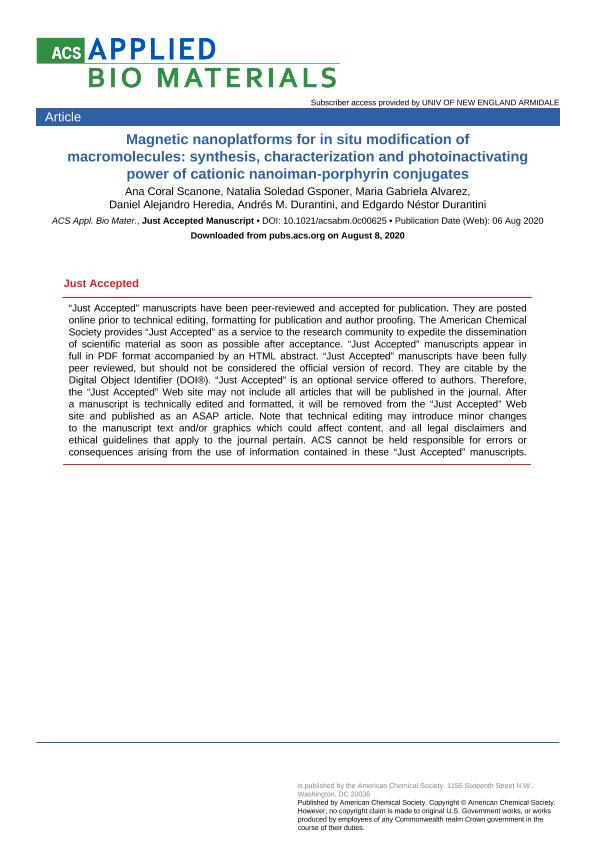Artículo
Magnetic Nanoplatforms for in Situ Modification of Macromolecules: Synthesis, Characterization, and Photoinactivating Power of Cationic Nanoiman-Porphyrin Conjugates
Scanone, Ana Coral ; Gsponer, Natalia Soledad
; Gsponer, Natalia Soledad ; Alvarez, María Gabriela
; Alvarez, María Gabriela ; Heredia, Daniel Alejandro
; Heredia, Daniel Alejandro ; Durantini, Andres Matías
; Durantini, Andres Matías ; Durantini, Edgardo Néstor
; Durantini, Edgardo Néstor
 ; Gsponer, Natalia Soledad
; Gsponer, Natalia Soledad ; Alvarez, María Gabriela
; Alvarez, María Gabriela ; Heredia, Daniel Alejandro
; Heredia, Daniel Alejandro ; Durantini, Andres Matías
; Durantini, Andres Matías ; Durantini, Edgardo Néstor
; Durantini, Edgardo Néstor
Fecha de publicación:
08/2020
Editorial:
American Chemical Society
Revista:
ACS Applied Bio Materials
ISSN:
2576-6422
Idioma:
Inglés
Tipo de recurso:
Artículo publicado
Clasificación temática:
Resumen
A nanoplatform concept was developed to synthesize accessible photoactive magnetic nanoparticles (MNPs) of Fe3O4 coated with silica. This approach was based on the covalent binding of 5,10,15,20-tetrakis(pentafluorophenyl)porphyrin (TPPF20) to aminopropyl-grafted MNPs by nucleophilic aromatic substitution reaction (SNAr) to obtain conjugate MNP-P1. After in situ modification, the remaining pentafluorophenyl groups of TPPF20 attached to MNPs were substituted by dimethylaminoethoxy groups to form MNP-P2. The basic amine group of these conjugates can be protonated in aqueous media. In addition, MNP-P1 and MNP-P2 were intrinsically charged to produce cationic conjugates MNP+-P1 and MNP+-P2+ by methylation. All of them were easily purified by magnetic decantation in high yields. The average size of the MNPs was ∼15 nm, and the main difference between these conjugates was the greater coating with positive charges of MNP+-P2+, as shown by the zeta potential values. Absorption spectra exhibited the Soret and Q bands characteristic of TPPF20 linked to MNPs. Furthermore, these conjugates showed red fluorescence emission of porphyrin with quantum yields of 0.011-0.036. The photodynamic effect sensitized by the conjugates indicated the efficient formation of singlet molecular oxygen in different media, reaching quantum yield values of 0.17-0.34 in N,N-dimethylformamide. The photodynamic activity of the conjugates was evaluated to inactivate the Gram-positive bacteria Staphylococcus aureus, the Gram-negative bacteria Escherichia coli, and the yeast Candida albicans. The modified cationic MNP+-P2+ was the most effective conjugate for photodynamic inactivation (PDI) of microorganisms. Binding of this conjugate to bacteria and photoinactivation capability was checked by means of fluorescence microscopy. Also, sustainable use by recycling was determined after three PDI treatments. Therefore, this methodology is a suitable scaffold for the in situ modification of conjugates, and in particular, MNP+-P2+ represents a useful photodynamic active material to eradicate microorganisms.
Archivos asociados
Licencia
Identificadores
Colecciones
Articulos (IDAS)
Articulos de INSTITUTO PARA EL DESARROLLO AGROINDUSTRIAL Y DE LA SALUD
Articulos de INSTITUTO PARA EL DESARROLLO AGROINDUSTRIAL Y DE LA SALUD
Articulos(INTEMA)
Articulos de INST.DE INV.EN CIENCIA Y TECNOL.MATERIALES (I)
Articulos de INST.DE INV.EN CIENCIA Y TECNOL.MATERIALES (I)
Citación
Scanone, Ana Coral; Gsponer, Natalia Soledad; Alvarez, María Gabriela; Heredia, Daniel Alejandro; Durantini, Andres Matías; et al.; Magnetic Nanoplatforms for in Situ Modification of Macromolecules: Synthesis, Characterization, and Photoinactivating Power of Cationic Nanoiman-Porphyrin Conjugates; American Chemical Society; ACS Applied Bio Materials; 3; 9; 8-2020; 5930-5940
Compartir
Altmétricas



